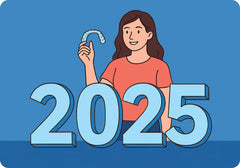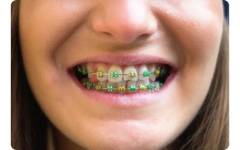Are you also on a quest for a straighter smile? More and more people are choosing between two primary types of orthodontic treatments, train track braces or clear aligners. Both sets of orthodontics aim to straighten your teeth and/or correct your bite, but each uses a very different method of achieving your goal.
When it comes to choosing what is best for you, the choice can be a little confusing. To make it easier to choose your best option, there are a few things to consider. In this guide, we will look at the pros and cons of each type and talk about these items from an effectiveness, lifestyle, cost, comfort, and fit (mostly for braces for teens in the UK) perspective.
Table of Content
What are train track braces?

Train track braces, formally known as traditional metal braces, have been used for decades and are still widely trusted by orthodontists worldwide. They consist of small metal brackets bonded to each tooth, connected by an archwire that gradually moves the teeth into their proper position. Elastic bands hold the wire in place, and the orthodontist tightens the wire at regular intervals to guide movement.
These braces remain fixed to the teeth for the duration of treatment, which typically ranges from 12 months to a year or more, depending on the complexity of the case.
Train track braces are highly effective at correcting:
-
Severe overcrowding
-
Large gaps between teeth
-
Misaligned bites, including overbites, underbites, and crossbites
-
Jaw alignment problems
They have proven to be reliable across all age groups and are often the first choice for treating complex orthodontic cases.
What are clear aligners?

Clear aligners are a modern, removable alternative to fixed braces. Brands like Caspersmile popularised this treatment, especially among adults and image-conscious teens. These aligners are custom-made using modern technologies and work by gradually shifting your teeth through a series of transparent, snug-fitting trays.
You typically wear each set of aligners for 10 days, removing them only when eating, drinking anything other than water, or brushing your teeth.
Clear aligners are designed to address:
-
Mild to moderate crowding
-
Small gaps
-
All bite corrections like overbite, underbite, overjet, and crowding
They offer a virtually invisible solution to teeth straightening, making them a preferred choice for people who want to keep their treatment low-key.
Your smile deserves the best!
Caspersmile Clear Aligners are here to provide you with affordable, at-home teeth straightening with maximum comfort.
Order Now
Clear aligners vs braces: Which is more effective?
The effectiveness of each treatment depends largely on the individual case, including the severity of misalignment, age, and compliance with treatment guidelines.
Train track braces:
-
Superior for complex cases: These braces allow for greater precision in tooth movement and are particularly effective in cases involving significant rotation, vertical movement, or bite correction.
-
Consistent force: Because they are fixed, they continuously apply pressure, ensuring consistent progress.
-
No patient responsibility for wear time: Since they cannot be removed, there's no risk of interrupting treatment due to forgetfulness or non-compliance.
Clear aligners:
-
Ideal for simpler cases: When the alignment issue is mild, clear aligners can be just as effective as metal braces.
-
Customised treatment plans: Each aligner is part of a digitally mapped sequence designed for progressive improvement.
-
Patient compliance is crucial: Aligners must be worn for at least 20-22 hours a day. Failure to meet this requirement can lead to delayed results or ineffective treatment.
Lifestyle and comfort comparison
Diet and eating habits
-
Train track braces: There are dietary restrictions to protect the brackets and wires. Sticky, hard, or chewy foods must be avoided.
-
Clear aligners: You can eat whatever you like, as the aligners are removed during meals. However, it is necessary to brush your teeth before reinserting them to prevent staining and tooth decay.
Oral hygiene
-
Train track braces: Brushing and flossing require more effort and specific tools to clean around brackets and wires.
-
Clear aligners: Because they are removable, it is easier to maintain your regular oral hygiene routine.
Comfort
-
Train track braces: Discomfort is expected after adjustments. Metal parts may cause irritation to the inside of the lips or cheeks, and people also ask how to stop braces pain, which can often be managed with orthodontic wax, over-the-counter pain relief, saltwater rinses, and eating soft foods.
-
Clear aligners: Generally more comfortable. The trays are smooth and less likely to cause abrasions, although there can still be initial pressure with each new set.
Which braces work faster?
The answer depends on your specific case:
-
For mild to moderate issues, clear aligners may produce results in as little as 3-5 months.
-
For moderate to severe cases, train track braces may take longer, 12 to 24 months, but offer more consistent and reliable results.
-
In complex orthodontic cases, traditional braces often work faster and more effectively due to their ability to control tooth movement in all directions.
It's also important to note that clear aligner treatment can be delayed if not worn properly. Every hour they are out of your mouth delays progress.
Cost comparison
Here's a cost comparison between the two.
Train track braces
-
NHS support: Available to children under 18 in the UK when medically necessary. This makes them a little less costly.
-
Private treatment: If not eligible through the NHS, private treatment may cost between £2,000 to £3,500, depending on complexity.
Clear aligners
-
Private only: Not covered by the NHS, so they are typically paid for out of pocket, but brands like Caspersmile offer aligners on a budget.
-
Price range: The costs of Caspersmile Clear Aligners start from £599.
Making the right choice
When deciding between clear aligners vs braces, there are several factors to consider:
| Criteria | Train Track Braces | Clear Aligners |
| Visibility | Highly visible | Nearly invisible |
| Effectiveness for complex cases | Highly effective | Effective for mild to moderate cases |
| Wear the discipline required | Low | High (22 hours daily) |
| Comfort | May cause mouth irritation | Generally more comfortable |
| Food restrictions | Yes | None (removable) |
| How long does it take to put braces on | Requires a whole session with the dentist | Instantly with a snap/td> |
| Cleaning ease | Difficult | Easy |
| Cost (UK teens) | Often NHS-covered | Private only (still affordable) |
If your main priority is effectiveness and reliability, particularly in complicated orthodontic cases, train-track braces are a better option. If your case is relatively simple and you're committed to wearing the aligners for the required hours daily, clear aligners can be an equally effective and more discreet choice
Caspersmile offers effective solutions to straighten your teeth
Low costs and comfort make it a popular choice for teens and adults
Order Now
Train track braces or clear aligners? The answer lies here
Whether you're a teen just starting your orthodontic journey or an adult revisiting your smile, both train track braces and clear aligners offer powerful tools to achieve beautifully aligned teeth. The right choice ultimately depends on the complexity of your dental issues, your lifestyle preferences, and your budget.
Consulting with an experienced orthodontist is key, they will assess your needs and recommend the most suitable treatment for long-term success. A straight, confident smile is an investment in both appearance and oral health, and with today's range of options, it's more accessible than ever.
FAQs

Citations
Baum, A. (2024b, October 2). Aligners vs. Braces: A Comparison. American Association of Orthodontists.
https://aaoinfo.org/whats-trending/braces-vs-clear-aligners/
Clear aligners or metal braces? Here's how to choose. (n.d.-b). Colgate.
https://www.colgate.com/en-us/oral-health/adult-orthodontics/clear-aligners-or-metal-braces-heres-how-to-choose
Related Articles
Subscribe our newsletter
By clicking subscribe, you agree to our Privacy Policy and opt in to receive communications from Caspersmile. You can unsubscribe at any time.




